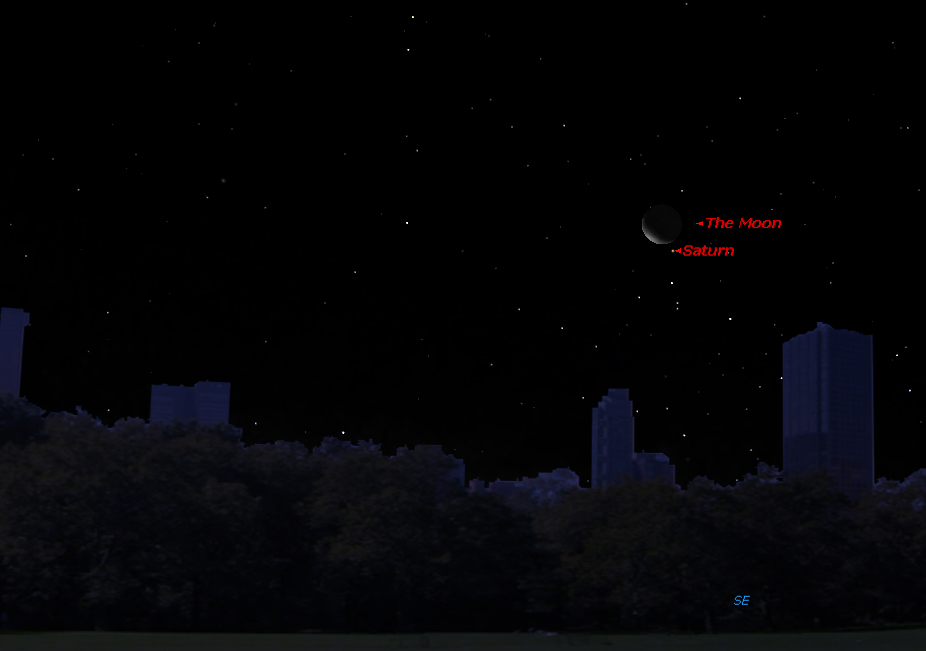
Early Friday morning, if skies are clear, you have a good chance to catch sight of a lovely waning crescent moon pairing off with the ringed wonder of the solar system: the planet Saturn.
Start looking low toward the east-southeast horizon around 3:30 a.m. your local time Friday (Jan. 16). Soon after the crescent moon — 21 percent illuminated — emerges from beyond the horizon, you’ll notice a bright non-twinkling yellow-white "star" shining sedately almost directly below it.
That will be Saturn.
If you have any obstructions, such as buildings or trees in your southeastern viewing area, you may have to wait awhile as Saturn and the moon slowly climb higher in the sky. They will be at their highest, appearing roughly one-quarter of the way from the horizon to the point directly overhead (the zenith) at around 5:40 a.m. local time – the start of astronomical twilight. [Related: The Brightest Planets in January's Night Sky]
By the break of dawn, Saturn will appear about 1.1-degrees below and a bit to the right of the moon. The apparent width of the moon is roughly equal to one-half of a degree, so Saturn will appear just over two moon widths from the moon itself.
In order to see the famous rings of Saturn however, you'll need a telescope magnifying at least 30-power. Their north face is now tilted more than 24.7 degrees to our line of sight. The rings have not been so inclined since late June 2004.
Saturn is currently 977 million miles (1.56 billion kilometers) from Earth. On the other hand, the moon is more than 4,100 times closer to Earth, at a distance of 235,300 miles (378,700 km).
Get the Space.com Newsletter
Breaking space news, the latest updates on rocket launches, skywatching events and more!
There is another striking target in the Friday predawn sky for the eagle-eye observer. The 1st-magnitude reddish star Antares will be shining 10 degrees (the equivalent of the width of your clenched fist held out at arm's length) to Saturn's lower left. Saturn appears to glow about 0.4 magnitude brighter than Antares.
Currently Saturn lies within the head of Scorpius, the Scorpion, which resembles a "fence" of 2nd and 3rd magnitude stars. Saturn is still about four months from opposition and as such will continue to slowly grow in prominence in the days and weeks to come.
Editor's note: If you capture a striking photo of Saturn and the moon, or any other night sky view, and you'd like to share it Space.com for a story or gallery, you can send in images and comments to managing editor Tariq Malik at: spacephotos@space.com.
Joe Rao serves as an instructor and guest lecturer at New York's Hayden Planetarium. He writes about astronomy for Natural History magazine, the Farmer's Almanac and other publications, and he is also an on-camera meteorologist for News 12 Westchester, N.Y. Follow us @Spacedotcom, Facebook and Google+. Original article on Space.com.
Join our Space Forums to keep talking space on the latest missions, night sky and more! And if you have a news tip, correction or comment, let us know at: community@space.com.

Joe Rao is Space.com's skywatching columnist, as well as a veteran meteorologist and eclipse chaser who also serves as an instructor and guest lecturer at New York's Hayden Planetarium. He writes about astronomy for Natural History magazine, Sky & Telescope and other publications. Joe is an 8-time Emmy-nominated meteorologist who served the Putnam Valley region of New York for over 21 years. You can find him on Twitter and YouTube tracking lunar and solar eclipses, meteor showers and more. To find out Joe's latest project, visit him on Twitter.









